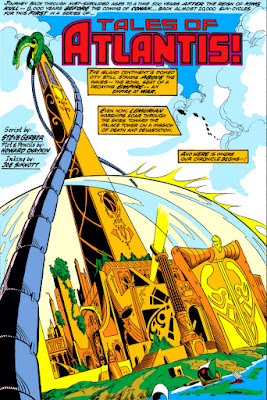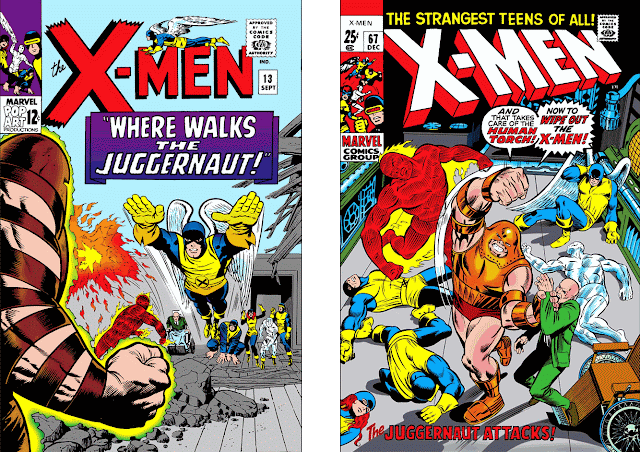In 1970, when
The X-Men title finally folded its tent and ceased publication of new stories with
issue #66, there followed a gap of nine months before the book began appearing on store racks once more--this time recycling itself as a reprint title, reaching back to the fall of '65 to begin its "new" run and sporting a 25¢
* price tag which suggested the issue would contain more than one previously published story. That format would continue for six issues before the book's length and price fell into line with Marvel's other books being published--with the exception of its bimonthly publication schedule, which lasted for the next eight years until 1978 when by that time the
next X-Men team was firmly established (and, at that point in time,
battling Magneto at the heart of a volcano).
*10¢ more than standard-length 20-page comics, though 36 pages in total if you included the staggering 16 additional pages of ads (third-party and Marvel-related), letters pages, Bullpen bulletins, and of course the Marvel checklist (which technically would have to fall under "ads").
For its first issue out of the gate after its period of dormancy, X-Men featured a foe who first appeared in 1965 and would go on to become the X-Men's mortal enemy, the Juggernaut--along with a blazing guest-star whose power and abilities were sorely needed in the team's dire hour of need. And for the occasion, artists Marie Severin and Joe Sinnott were tapped to recreate Jack Kirby's original cover--bringing Sinnott, who also had inked Kirby's cover, full circle.
Kirby and Severin obviously have a different approach in presenting the threat, with Severin cutting to the chase and showing Juggernaut having advanced through the team's defensive measures and now poised to destroy the lot of them; yet as the cover also meant to grab the attention of anyone browsing comics for sale, it presents a more visual, more animated appeal than the looming threat which Kirby depicts, while also prodding any former X-Men readers who might have been hoping for the title's resurgence.
Within, however, as the original story is again presented, whatever prospects of excitement that Severin's cover might have indicated for the issue's story dim somewhat, with Kirby by then having shifted to doing layouts for the book while artist Jay Gavin (a.k.a. Werner Roth) was being groomed as the book's new regular artist. Gavin had yet to find his groove with these characters (as he would), and he was a marked improvement over Alex Toth from the prior issue where Juggernaut made his debut--but even with Sinnott, as well as the addition of the Torch, the action here comes off as stiff. (Granted, the Juggernaut himself doesn't help in that regard, as the story has him mostly threatening and steadily advancing while everyone tries to halt him.)
As for what brings the Torch to Xavier's school, he happens to catch a bit of Xavier's mental waves which have swept over New York (it's a little more convoluted than that, but you catch my mental drift)--and Xavier, with the Juggernaut at his doorstep and in no position to turn down aid, entreats him to help. And no doubt that help would more than tip the scales against this foe, were it not for a handy dandy force field which you'd think a human juggernaut by definition wouldn't need.
Finally, though, a little teamwork saves the day--nor, does it seem, is the Juggernaut's force field much use against a winged opponent when the man himself is too unfocused to invoke it. (For some reason I thought the field was always present no matter what, but what do I know.)
With the threat dealt with, Xavier wipes the Torch's memory and sends him flying back to New York none the wiser--the reason being that, during this time, Xavier still wishes to keep his association with the X-Men a secret. If memory serves (heh, get it?), that association as well as Xavier's mental abilities are known to a confidant in the F.B.I.--yet at some point, that information becomes known to super-beings and perhaps even the N.S.C. and the White House. And despite the strange mental waves which seem to be prodding your humble host to put these thoughts aside, the PPC will be exploring that subject in the near future.
Wait... I was going to... what's happening...























